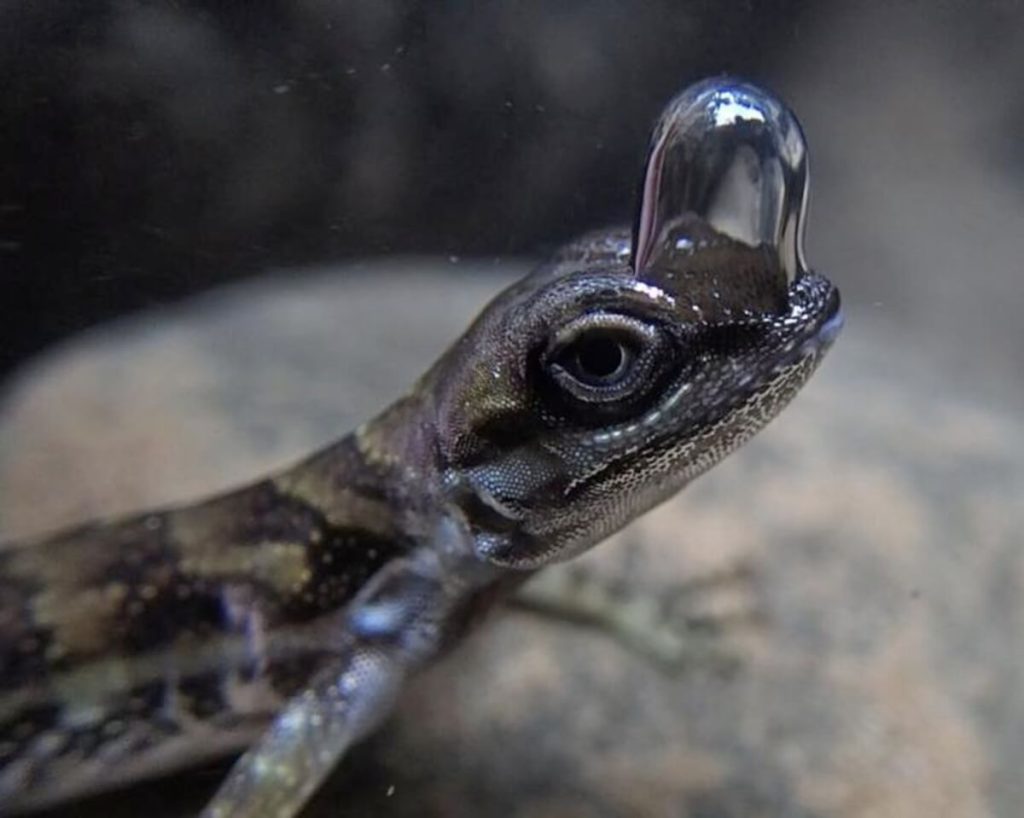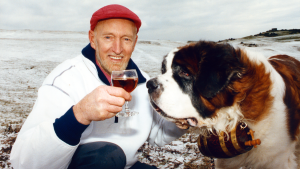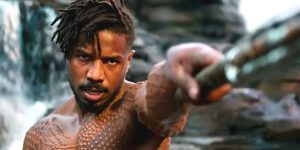

A species of semi-aquatic lizard produces a special bubble over its nostrils to breathe underwater. (Credit:
Lindsey Swierk)
BINGHAMTON, N.Y. — In Costa Rica’s rushing streams, scientists have discovered a tiny scuba diver that has a unique way of escaping the wrath of predators. The water anole, a tiny lizard no bigger than a finger, has mastered an underwater breathing technique that’s baffling researchers. It creates and rebreathes an air bubble that functions like a portable oxygen supply, allowing it to hide from predators and breathe underwater for extended periods of time.
The water anole (Anolis aquaticus), which researcher Lindsey Swierk from Binghamton University describes as “the chicken nuggets of the forest,” can dive and remain submerged for up to 20 minutes by exhaling a bubble of air that clings to their head like a natural scuba tank. Study results published in Biology Letters revealed that when water anoles are able to rebreathe their air bubbles normally, they can stay underwater 32% longer compared to lizards prevented from using this unique adaptation. This discovery marks the first evidence of a vertebrate animal using bubbles for underwater respiration—a feat previously only known in invertebrates like diving beetles and water spiders.
Water anoles belong to a diverse group of small tropical lizards found throughout Central and South America. While most anole species live in trees or on the ground, several have independently evolved semi-aquatic lifestyles, adapting to life near streams and rivers. These water-loving lizards have developed specialized features including water-repelling skin and modified scales that help them thrive in their aquatic environment.


Lindsey Swierk)
The mechanics of this rebreathing system are remarkable. When threatened, a water anole will quickly dive underwater and exhale a bubble that adheres to either the top or sides of its head. The lizard’s skin contains microscopic hair-like structures called spinules that trap air and repel water, allowing the bubble to stick to its body. Throughout its dive, the anole “rebreathes” this bubble at regular intervals, appearing to recycle the trapped air supply. The bubble can be observed appearing and disappearing around the head with each respiratory cycle as specialized scale and head structures help move air between the body surface and nostrils.
For these small lizards, this underwater breathing adaptation could mean the difference between life and death. Birds and snakes frequently hunt water anoles, making them vulnerable prey in their forest habitat. The ability to dive and remain motionless underwater provides crucial protection from these predators. The lizards are well-camouflaged beneath the surface and can stay submerged until the threat passes; a strategy that would be far less effective without their bubble-breathing capability.
To test whether these bubbles actually serve a functional purpose or were merely a byproduct of the lizards’ water-repelling skin, Swierk devised an elegant experiment. She collected 30 water anoles (24 males and 6 females) from the Rio Java at Las Cruces Biological Station in Costa Rica. The lizards were divided into two groups: a control group that could rebreathe normally, and a treatment group that had a thin layer of moisturizer applied to their heads to prevent bubble formation.
“Lizard skin is hydrophobic. Typically, that allows air to stick very tightly to the skin and permits this bubble to form. But when you cover the skin with an emollient, air no longer sticks to the skin surface, so the bubbles can’t form,” explains Swierk, in a statement.
Lizards able to form and rebreathe their bubbles remained underwater for significantly longer periods, averaging about 67.5 seconds more dive time than those without bubble access. This represents a 32% increase in underwater endurance, which is a meaningful advantage when hiding from predatory birds or snakes.
Beyond just extending dive times, the study revealed fascinating details about how these lizards manage their underwater breathing. In addition to bubble rebreathing, the anoles use an ancestral lizard behavior called “gular pumping” where they pump their throat to move air around. This pumping action helps circulate air from the throat region to the lungs. Interestingly, while the moisturizer treatment blocked bubble formation, it didn’t affect gular pumping rates, suggesting these are separate but potentially complementary systems.
The discovery has sparked new questions about how these lizards might be maximizing their underwater breathing capabilities. Researchers are now investigating whether water anoles might be using their bubbles as a “physical gill,” a mechanism well-documented in aquatic insects. In insects, oxygen from the surrounding water can actually diffuse into their air bubbles, supplementing their oxygen supply. However, given the larger size and higher oxygen demands of lizards compared to insects, the research team suspects that water anoles may be too large to rely solely on oxygen diffusion through their bubbles.


Understanding how these lizards manage to breathe underwater could inspire innovations in human technology. The water-repelling properties of their skin and their ability to maintain stable air bubbles underwater might inform the development of new materials or underwater breathing apparatus. Scientists are particularly interested in the microscopic structures that allow the lizards’ skin to trap and manipulate air bubbles so effectively.
This discovery also highlights how much remains unknown about animal adaptations, even in seemingly well-studied groups like lizards. The water anole’s bubble-breathing ability represents convergent evolution where similar traits evolve independently in different species facing similar environmental challenges. Several groups of semi-aquatic anoles have developed this rebreathing ability, suggesting it provides a significant survival advantage in their aquatic habitat.
“I’ve had people talk to me about how much they love scuba diving and freediving, and how they’re interested in how animals might do the same thing,” says Swierk. “There’s a great opportunity to get people excited about science by having this relationship between what they love to do and what’s evolved in nature.”
Paper Summary
Methodology
The study used a straightforward experimental design comparing two groups of lizards – one that could rebreathe normally and another prevented from forming bubbles by applying moisturizer to their heads. The researchers created a controlled environment using a clear plastic tank (74 × 45 × 34 cm) filled to 30 cm with fresh stream water and equipped with underwater cameras. Each lizard was placed in the tank and allowed to grasp an underwater perch, while observers behind a blind recorded dive times and breathing behaviors. As Swierk explains, “We didn’t know whether there was actually any functional role for this bubble in respiration. Is it something that lizards do that is just a side effect of their skin’s properties or a respiratory reflex, or is this bubble actually allowing them to stay underwater longer than they would, say, without a bubble?”
Results
In controlled trials, lizards able to form normal bubbles stayed underwater significantly longer than those treated with moisturizer to prevent bubble formation. The control group averaged 67.5 seconds more dive time, representing a 32% increase in underwater endurance. Statistical analysis confirmed this had a “large” effect on dive duration. While bubble rebreathing was impaired in the treatment group, gular pumping rates remained similar between groups, suggesting this behavior operates independently of bubble rebreathing.
Limitations
The research had several notable constraints. The sample size was relatively small at 30 lizards, and females were underrepresented (only 6 compared to 24 males). The study was conducted in a controlled tank environment rather than natural streams, which might affect diving behavior. Additionally, one control group lizard was excluded as an outlier due to an unusually long dive time. The researchers also note that while they demonstrated the bubbles’ role in extending dive time, they haven’t yet determined the exact physiological mechanisms involved.
Takeaways and Discussion
This study provides the first experimental evidence that bubble rebreathing in vertebrates serves a functional role in extending dive time, though the behavior itself had been previously observed, a capability previously only known in invertebrates. The study suggests this adaptation helps water anoles extend their underwater refuge time when escaping predators. Graduate student Alexandra Martin is currently investigating whether physical gill-type action might allow lizards to extend their dive times even further by studying how water oxygenation affects their underwater endurance. The findings also highlight potential applications for bio-inspired underwater technologies, particularly in developing new water-repellent materials and underwater breathing systems.
Funding and Disclosures
The research was supported by an Individual Development Award from Binghamton University NYS/UUP. The study was reviewed and approved by the Organization for Tropical Studies, and research permits were obtained from the Ministry of the Environment and Energy, Republic of Costa Rica. The author declared no competing interests and confirmed no use of AI-assisted technologies in creating the article.
Publication Information
The study, “Novel rebreathing adaptation extends dive time in a semi-aquatic lizard,” was published in Biology Letters (2024), Volume 20, Issue 20240371. Lindsey Swierk from the Department of Biological Sciences at Binghamton University and the Amazon Conservatory for Tropical Studies conducted the research.








